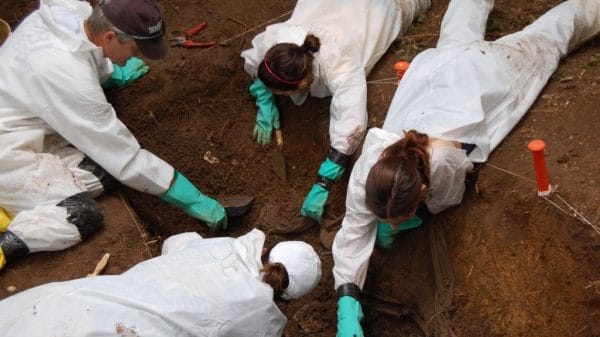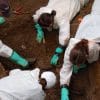This is seriously stomach-churning, but you know what? That’s the kind of shit you weirdos love! The kind of fascinating, disgusting, horrifying, can’t-look-away shit. So today we have the stages of decomposition of a corpse, complete with color photos of each stage from Body Stain to Skeletonization. Yes, body stain – the kind of thing the cops find on the tan carpet when the neighbors start to complain about the smell. Nasty. Enjoy!
Via Scribol
Text: Asher Kade
Body Stain
Consider it morbid, but most people wonder what happens to them when they die. My baby sister is currently growing another human being inside her, while my father is slowly but surely losing his own life. Life and death is a sad and beautiful thing. What happens to us when we die?
Pallor Mortis is something that is more noticeable in light skinned people. The loss of blood in the capillaries happens rapidly, within minutes of death.
Unless medical staff have the chance to come upon a dead person right after death, this stage is not going to be of any use to predicting the time of death.
Algor mortis is when the body begins to cool. Within the first hour, the body will lose two degrees in temperature. Then, every hour afterward, it will lose one more degree of temperature until it is the temperature of the environment it is in.
Rigor mortis is the stage most people are familiar with, if they know their CSI. It is when a dead person becomes stiff. It begins after three hours of death, reaching full stiffness after 12 hours. Then, three days after death, the body becomes soft again as it slowly decomposes. This can be a bad thing when it comes to processing meat, so the animal’s carcass is injected with an “alternating current” to prevent this from happening, thus preserving the quality of the meat.
Livor mortis is the next stage, when the blood begins to pool to the lowest part of the body. Since the body no longer combats gravity by pushing the blood around, the blood just resorts to falling down to the lowest level. This is not a pretty sight, as one can see here.
Livor mortis happens within six to twelve hours. The pattern of lividity can help medical professionals know the initial position of the body when the person died, and if the body had been moved around afterward (differing pooling of blood patterns).
Decomposition is the next stage — even more unsettling to look at than the prior stage. I have seen this stage first hand. The smell is unforgettable.
Then, bloat—or putrefaction occurs, marked by the production of vapors. The body’s cells are rupturing and breaking apart. The intestines push out and fall prey to distension. You will note a greenish color in the skin because of the sulfhaemoglobin forming in the blood. The skin breaks apart often and the insides purge out. Insect activity begins to take shape.
To see images of insect activity, click here.
A fresh decomposition is called autolysis. It is the formation of liquids. That doesn’t even happen until the dead body is four days old.
Decay is marked by the breaking down of the body. Bacteria, fungi, and protozoa begin to move in, as insect and possibly animal activity begins to become more rampant. The darker the color of the body, the longer the person has been dead. Also evident are blisters or skin slippage.
Skeletonization or diagenesis is the final stage. The moisture in the body is lost. The bones are visually evident. Two years is typical in moderate temperature, whereas in hot climates like Africa, skeletonization may occur as quickly as in two weeks.
Temperature is the leading factor in the rate of decomposition; moisture only to a lesser degree. If a body is submerged under water or dirt, the body will decompose at a slower rate. Injuries also play an important role, as breaking of the skin invites insects and/or animals to hasten the process of decay.
Bones, in the first year of death begin to bleach and moss or algae may grow on them. After a decade, big cracks will form. According to this source, roots from nearby vegetation may grow into the bone mass, significant rodent gnawing will be present and the appearance of annual leaf falls may be evident.







